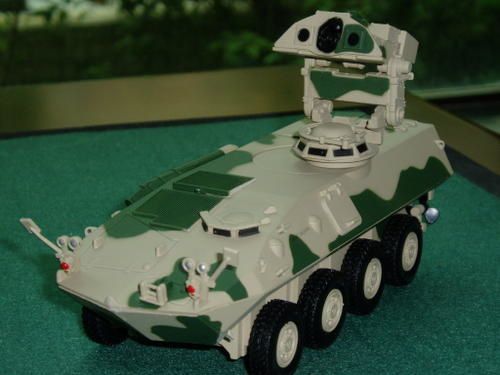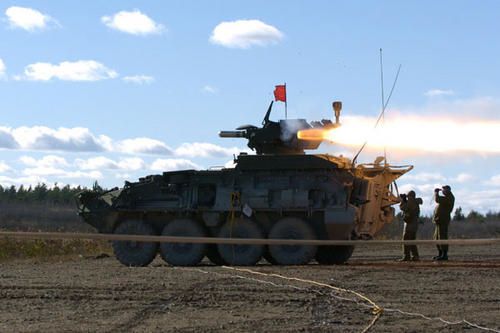


IMPROVED TARGET ACQUISITION SYSTEM (ITAS)
The Improved Target Acquisition System (ITAS) is a planned upgrade to the Tube-Launched Optically-Tracked, Wire-Guided (TOW) 2 anti-tank weapon system for the light forces. It is an integrated day/night sight that employs a second generation Forward Looking Infrared to enable gunners in acquiring targets at ranges greater than achievable with the current TOW sight. In addition, ITAS has an eye-safe Laser Range Finder, automatic boresighting, Aided Target Tracker, and Built-In-Test/Built-In-Test Equipment (BIT/BITE). ITAS incorporates an embedded training capability. ITAS is a precision engagement system designed to enhance the Army's ability to dominate the ground maneuver battle.
ITAS can be used with all current versions of TOW, and has been designed to be used with a potential, future anti-tank missile system. ITAS can be operated in a man-portable configuration using a ground-mounted tripod or it can be mounted on a vehicle—currently the High-Mobility Multi-Purpose Wheeled Vehicle. ITAS has a high degree of commonality with the Improved Bradley Acquisition System, which will be integrated into the Bradley Fighting Vehicle System-A3.
BACKGROUND INFORMATION
ITAS IOT&E was conducted in 4QFY96. IOT&E found ITAS to be operationally effective but not operationally suitable. ITAS did not meet most reliability and maintainability requirements. Additionally, the BIT/BITE performance was unsatisfactory and the laser range finder failed to meet accuracy requirements. A Customer Test was conducted in February 1998 to address outstanding ITAS performance issues from IOT&E. Once again, ITAS failed to meet suitability requirements. The system achieved an 80-hour Mean Time Between Operational Failures (MTBOMF) rate against the 140-hour MTBOMF requirement. Additionally, the BIT/BITE false alarm rate exceeded the requirement. During the Customer Test, ITAS continued to successfully demonstrate its capability to engage targets with the TOW missile.
TEST & EVALUATION ACTIVITY
The ITAS Limited User Test II (LUT II) was conducted in February 1999. LUT II was designed to evaluate system suitability requirements unmet in previous OT. In addition, this test evaluated the effectiveness and suitability of the Field Tactical Trainer (FTT). FTT is a laser engagement system designed to support force-on-force training with ITAS.
ITAS successfully met its suitability requirements during LUT II. It achieved a MTBOMF of 294 hours against a 140-hour requirement. Additionally, BIT/BITE performed satisfactorily, achieving a 92 percent Fault Isolation Rate versus the 90 percent requirement, and a 100 percent Fault Isolation Rate versus the 86 percent requirement. FTT also performed adequately as a force-on-force training system.
LUT II did identify a shortfall in the capability of the Battery Power Source to consistently recharge as designed to meet the system's desired 96-hour mission profile. Technical fixes to this shortfall were applied by the program and successfully demonstrated in a subsequent test.
The ITAS Milestone III decision was made favorably by PEO, Tactical Missiles in May 1999.

TEST & EVALUATION ASSESSMENT
Based upon the results of previous testing, the Director has assessed ITAS to be both operationally effective and suitable. In a series of operational tests ITAS successfully demonstrated improved operational effectiveness in comparison to the baseline TOW weapon system it is designed to replace. ITAS has demonstrated an increased capability to detect and recognize targets at greater range and under conditions of limited visibility, as well as an improved capability to hit targets with the TOW missile. Additionally, the incorporation of system BIT/BITE capability offers potential improvements in battlefield sustainability.
The Director has identified two ITAS training issues, which he has recommended to the Army for further examination. First, while the system's Aided Target Tracker (ATT) has demonstrated potential capability to improve the gunner's ability to maintain target track, particularly during the initial post-missile launch obscuration, operational testing has revealed gunner reluctance to employ this capability. This reluctance appears, in part, to be the result of inadequate training and immature tactical procedures in employing ATT capability. Second, the Army currently lacks an appropriate training device to support basic ITAS gunnery skills training. The Field Tactical Trainer, while adequately supporting force-on-force training, does not meet the need for basic gunner training. Such gunner skills as use of ATT laser range finder, BIT/BITE, thermal vehicle signature identification, and target tracking can only be trained economically and efficiently with an appropriate basic gunnery skills trainer. Although the Army has identified this requirement, it is currently unfunded. This shortfall raises important questions as to how the Army intends to train and maintain TOW gunnery proficiency in the future.





















/idata%2F0396584%2FKOREA%2F71910_korea_MIA1_800.JPG)
/idata%2F0396584%2FU.S.ARMY-POST-WW2%2Fphot4901a.jpg)
/idata%2F0396584%2FDRAWINGS-UNIFORMS-WW2%2F30-451-09b-2.jpg)
/idata%2F0396584%2FP-40%2F44FS000.jpg)
/idata%2F0396584%2FGERMAN-U-BOAT%2FBundesarchiv_Bild_101II-MW-1031-28-_Lorient-_U-31.jpg)
/idata%2F0396584%2FSOVIET-ARMY-WW2%2F1.jpg)




